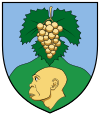Samu (fossil)
47°37′37″N 18°23′02″E / 47.627°N 18.384°E
Homo neanderthalensis? Homo heidelbergensis | |
| Age | 325-340 ka |
|---|---|
| Place discovered | Vértesszőlős Early Man Site, Hungary |
| Date discovered | 21 August 1965 |
| Discovered by | László Vértes and team |
Samu (VSZ II) is the nickname given to a fragmentary
Discovery
The find was made on August 21,1965 during a dig led by
At the same time as the occipital, 'several lower'
A replica of the Samu occipital bone is on exhibit in the Hungarian National Museum,[6] as well as associated tools and fossilized animal footprints.[7] Since discovery, the occipital has drawn great tourist attraction and scientific interest.[3] "Samu" has become a common name for plastic skeletons shown in biology classes in Hungarian student slang.[8]
Vandalism scandal
In 2009, news sources claimed that a 14 year-old girl
Description
The occipital fragment probably belonged to an adult individual, but it is very thin and flattened at the top-rear. The nuchal hump is very developed and, in life, would have supported very robust neck
The
Classification
The fossil was first described as Homo erectus (seu sapiens) paleohungaricus by Hungarian
Others remained divided by the apparently large volume and Neanderthal-like traits (which drew criticism, as the nuchal region of Samu is unlike Neanderthals).
Roksandic, Radović, and Lindal (2018) suggest that the specimen is alike to
Technology

In 1966, István Skoflek discovered evidence of fire and charred animal bones dating to 350 ka probably belonging to a hunting camp. The bones were found within the fire, and were probably used to keep the fire alive. Alongside the bone fragments was a
Diet
As the site becomes less ancient, the technology becomes more advanced in their manufacturing. As well, a bone culture was identified and similar to the stone tools in production. Other bones bore traces of marrow extraction and meat trimming. The area was abundant in food, and the ancient people hunted herbivores of various sizes and predators alike. Skeletal evidence suggests that horses were the most common food item, but aurochs, bison (such as Bison schoetensacki[14]), deer, wolves, and roe as well as bear fossils were discovered, although it is undetermined if the bears were hunted or brought by people from another location. Animals that died of non-human causes are present as well.[3]
Paleoecology
Notes
- 1. ^ The author of this study agrees with the classification of the Vértesszőlős fossils as early Neanderthals, but those such as Roksandic et al. suggest affinities with specimens typically assigned to Homo rhodesiensis or Homo heidelbergensis.
References

- ^ János Ladó, Ágnes Bíró, Magyar utónévkönyv (2005), p. 109.
- ^ .
- ^ ISSN 1804-6665.
- ^ Kordos, L., "Revised biostratigraphy of the early man site at Vertesszolos, Hungary", Courier Forschungsinstitut Senckenberg 171 (a May 1994), 225–236.
- ^ Kele, Sándor; Markó, András; Cseh, Julianna; Shen, Chuan-Chou; Wu, Chung-Che; Bernasconi, Stefano M. (2015). "Dating and clumped isotope-based temperature of a paleo-jacuzzi (Vértesszőlős Early Man site, Hungary)". Abstract Book of 31st IAS Meeting of Sedimentology: 267.
- ^ a b c "Samunak kutya baja - FN.hu". 2009-02-10. Archived from the original on 2009-02-10. Retrieved 2023-08-17.
- ISBN 978-0-253-00987-6.
- ^ Hogyan beszél ma az ifjúság? (paper on student slang)
- ^ "Megrongálta egy 14 éves Samu maradványait". 2011. Archived from the original on 2011-07-21. Retrieved 2023-08-17.
- ^ "seu", Wiktionary, the free dictionary, 2023-08-10, retrieved 2023-08-17
- ^ ISSN 0197-7261.
- PMID 34710249.
- S2CID 250070886.
- ^ S2CID 258795364.
- ^ Naddeo, Michelangelo (2023). "Az ősi magyar jelképrendszer keresése" (PDF). Acta Historica Hungaricus. 38.
- ^ Dobosi, Viola T. (2011). "Obsidian use in the Palaeolithic in Hungary and adjoining areas" (PDF). Natural Resource Environment and Humans. 1: 83–95.


